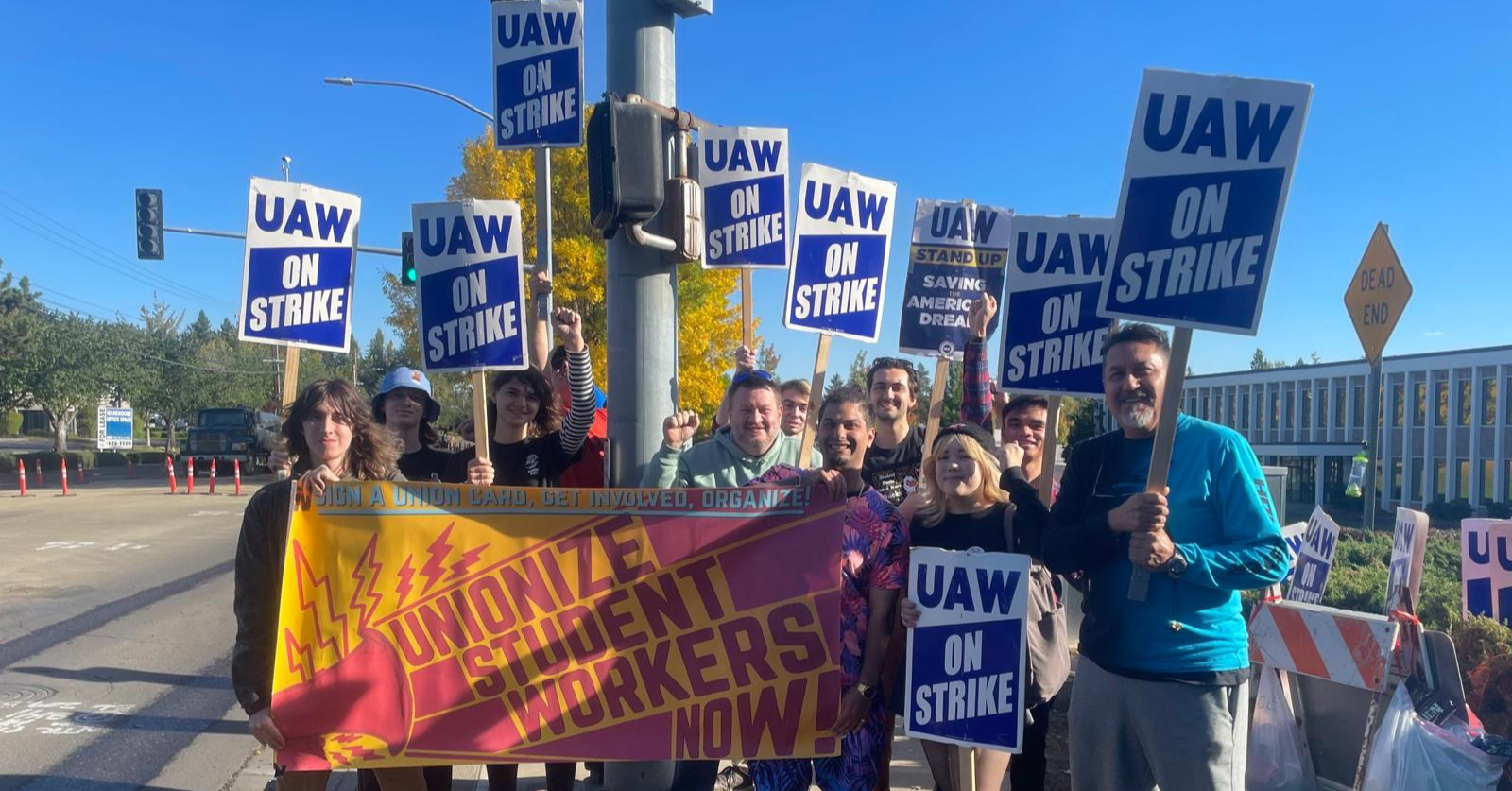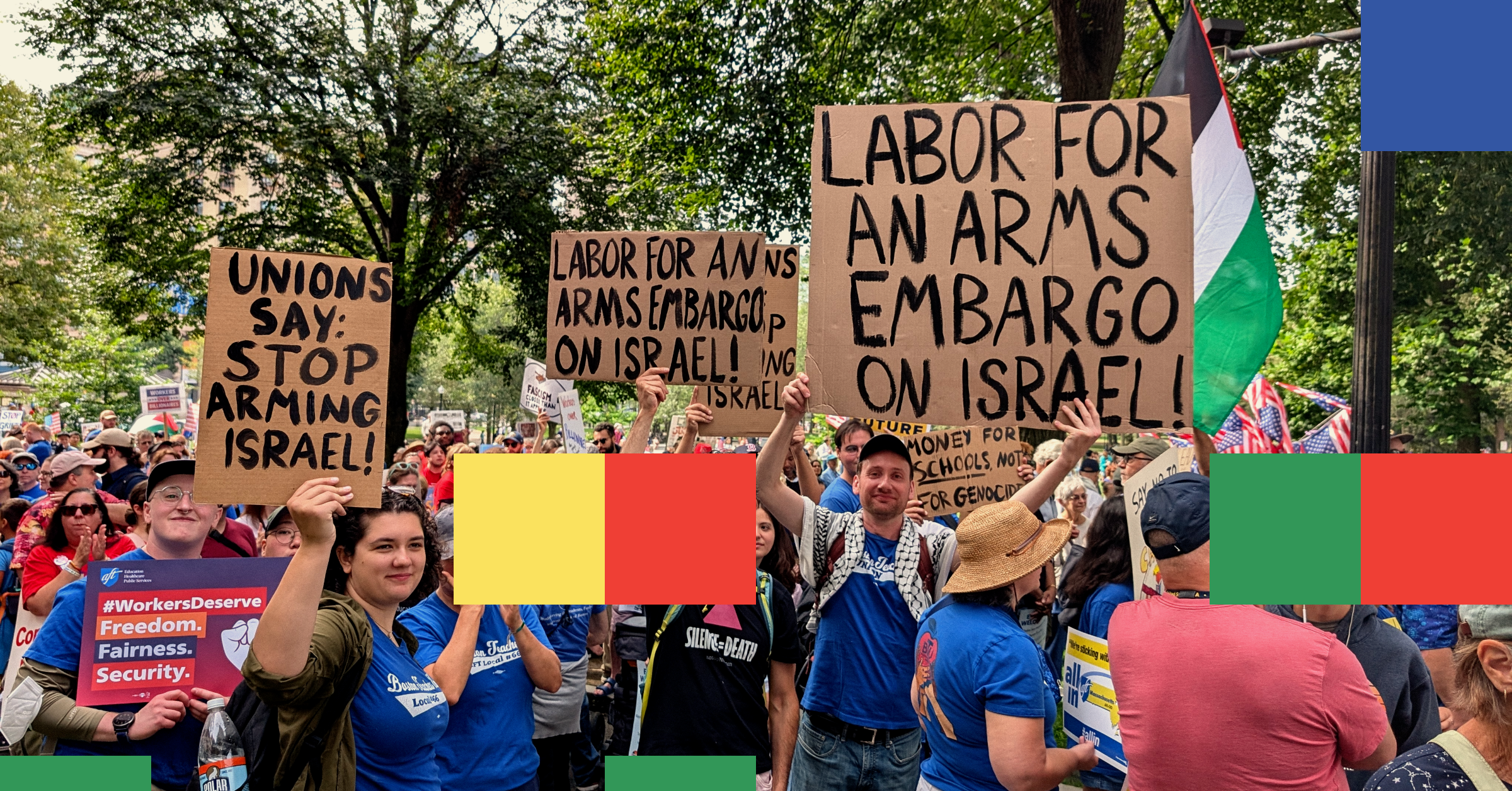On October 25th, undergraduate student workers at the University of Oregon (UO) made history. In a landslide vote, over 1,000 student workers voted to form a wall-to-wall labor union comprising nearly 4,000 workers across campus. University of Oregon Student Workers (UOSW) is now the largest union of its kind in the United States, and the first breakthrough for the growing undergraduate labor movement at a large public university.
More public sector breakthroughs are on the way. In December, undergraduate dining hall workers at the University of California Santa Barbara (UCSB) filed to form a union with the United Auto Workers (UAW). The same week, 1,100 undergraduate workers at Western Washington University (WWU) filed cards to form a union, as part of UAW’s efforts to organize graduate and undergraduate workers across the state. At the end of January, a staggering 19,000 workers are set to vote to form a union for undergraduate student employees across the 23-campus California State University (CSU) system, as part of an SEIU-backed organizing drive.
With legal certification in hand, student workers at UO, UCSB, WWU, and perhaps soon the CSU system are now preparing to bargain for first contracts with their universities. With the power of a union, workers can win big improvements in the workplace, like a $21 per hour minimum wage.
UOSW, which we helped found, is a landmark achievement for student workers at UO and beyond, but its significance goes beyond its effects on one campus or even in the higher education sector more broadly. UOSW is by far the largest union to ever come out of a DSA-driven organizing campaign. It demonstrates clearly why YDSA is a vital part of DSA. Like many of the organizing drives in the undergraduate labor movement, it was led from the start by YDSA members who gambled that a campaign to organize student labor could advance both the rank-and-file strategy and the broader struggle for democratic socialism.
Undergraduate union drives can do more than win better wages and working conditions for student workers. They can also unlock broader social and political possibilities, what we call “spillover effects.” If realized at scale, we believe these effects could meaningfully shift the terrain of class struggle in the United States.
We discuss five kinds of spillover effects: sector effects on the university system, affiliation effects on the broader labor movement, molecular effects on the consciousness of ordinary students, pipeline effects via the rank-and-file strategy, and cadre effects for the socialist movement.
(For readers interested in the history of UOSW and details about our campaign strategy, see our companion piece in The Activist.)
Sector effects
First, organizing these unions can have direct effects on the university system. Higher education is not a “strategic” industry in the same way as K-12 education, health care, logistics, or energy. In general, socialists should be striving to expand our movement beyond universities to reach the majority of workers who lack a college degree.
But struggle over the shape of higher education is still important, and undergraduate union campaigns can open up new possibilities on this front. Like K-12 educators’ unions, undergraduate unions can bargain for the common good of students and community (around tuition, for example).
More ambitiously, undergraduate unions can form cross-campus labor coalitions to claw resources and power back from university administrators. They can apply upwards pressure through strikes and political campaigns aimed at state policymakers for expanded investment and eventually to win universal College for All legislation. And in situations where students are already mobilizing around a political issue, like the current movement for Palestinian solidarity, the existence of a student worker union could be a powerful boost to mass action.
Affiliation effects
Second, undergraduate student worker unions, especially at large public universities, are positioned to influence the internal politics of the established unions they affiliate with in significant ways.
Workers in campus jobs are young, educated, and disproportionately left-leaning. The most engaged layer of this workforce (including young socialists) is often drawn to union activity through involvement in or identification with social movements and campus or community activism. For these reasons, undergraduate unions are primed to help revitalize the labor movement by joining reform efforts in their affiliate unions.
Connecting with these reform currents can quickly involve young workers in economic and political struggles of national importance. For a socialist movement that needs to accelerate class formation as quickly as possible, supporting rank-and-file reform efforts in key unions is an essential task. Organizing and affiliating student workers can add to that effort.
Molecular effects
Third, undergraduate labor organizing can have an impact on the attitudes and worldview of ordinary students. This “molecular” effect reaches beyond the ranks of student workers themselves to encompass the many thousands of students (especially working-class students) not employed on campus who will interact in some way with the union.
As with all organizing, the power to win is in the community. Effective strategists in undergraduate union campaigns will prioritize ways to engage student workers as members of the broader campus community. That means bringing the union struggle into the numerous other organizations and networks — ethnic, recreational, religious, pre-professional, even Greek life — that tie students together.
Even for those many students who will remain on the sidelines, the experience of simply witnessing collective action by one’s peers and friends could have a deep effect on attitudes and beliefs. Exposing huge numbers of students to class struggle — nearly 19 million students were enrolled in college in 2023, with over 450,000 in the California State system — could have a deep and unpredictable effect on American culture over time.
Pipeline effects
These campaigns can also have a direct role to play in the rank-and-file strategy, by putting worker-organizers on a pipeline into the labor movement after graduation.
UOSW spans dozens of workplaces across a sprawling university campus. In each workplace – each dorm, dining hall, cafe, library, and office — there will be workers with some capacity to lead their coworkers in collective action. Many of these ordinary worker leaders will not begin as student activists, let alone socialists. But through the process of organizing in their union, their identity and worldview can be transformed, and with it, their plans for the future. In a large union like UOSW, some of these organizers might make the choice to keep building the labor movement after graduation by industrializing in a strategic job.
Socialists doing work to build undergraduate unions can help this process by building pipelines that support graduating workers interested in taking a job to organize a union or support reform currents within existing unions. For example, in UOSW, we’ve built a small but functional pipeline to channel graduating union organizers into the independent union movement in Portland, where one of us (Liam) is now organizing.
If the undergraduate student movement is organized at a national scale, there could be pipelines carrying thousands of energetic young organizers into Amazon warehouses, Starbucks stores, and public schools each year. The effect of college-educated workers joining the labor movement has already been significant. If coordinated at a national scale, the impact could be transformative.
Cadre effects
Finally, undergraduate union campaigns can have positive benefits for developing the skills and politics of young socialists involved in them. UOSW would never have been possible without the efforts of socialists in UOYDSA, as well as the mentorship and support of Y/DSA members in Portland, Eugene, and elsewhere around the country (especially experienced labor organizers in Bread & Roses).
This was the main conclusion reached by a core UOSW organizer in her honors thesis written about the campaign. But the relationship wasn’t one-way: the demands of building a labor union from the ground up exerted pressure on UOYDSA to expand its own strategic capacity.
As the UOSW campaign developed, it turned a small group of socialists from political hobbyists into nearly full-time organizers and strategists. Today, UOYDSA has grown into one of the largest and most dynamic chapters in YDSA, with around fifty members attending weekly meetings and a core leadership team of over a dozen members, with multiple members serving on YDSA’s national committees.
Founding and leading an undergraduate union campaign is one of the best ways to build strong YDSA chapters and make lifelong socialist organizers. Union campaigns force socialists to think strategically about power and learn how to frame class struggle to ordinary working people (to “become normal,” as some UOYDSA members jokingly describe it).
The long-term promise of socialist participation in undergraduate union campaigns is to develop cadre: confident, experienced, and mature political actors able to build DSA, mentor other socialists, and help workers learn to fight and win, in the workplace and throughout society.
What’s Next for the Undergraduate Labor Movement?
We believe that the undergraduate labor movement is primed for rapid expansion. Public support for unions is historically high, especially among young people. With new breakthroughs at large public-sector universities, the undergraduate student labor movement is on track to become a real factor in the higher education labor movement.
The crucial question is whether and how these campaigns can contribute to the revival of working-class politics off the campus. We believe that young workers on college campuses have the power to set off spillover effects that flow across the higher education sector, into established unions, and through the attitudes of millions of college students. And for young socialists, these unions can be a school to develop invaluable political skills for the future of our movement.
At a time when DSA is urgently debating the future of our organization — and YDSA is suffering deep cuts to its budget — we hope that the example of UOSW and other undergraduate union efforts will remind our older comrades that “we are the party of the future, and the future belongs to the youth.”




